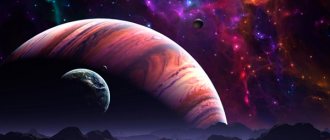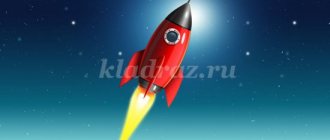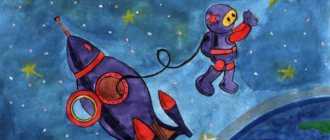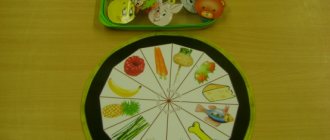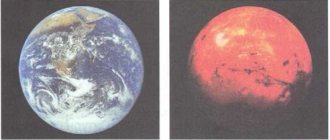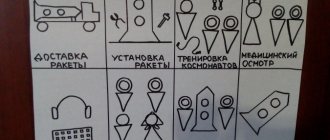Our planet Earth, on which we live, is part of the solar system. In the center of the solar system, a hot star shines brightly - the Sun. Eight main planets revolve around it at different distances from the Sun. One of them, the third in a row, is our Earth.
Each planet has its own orbit in which it moves around the Sun. A complete revolution around the Sun is called a year. On Earth it lasts 365 days. On planets that are closer to the Sun, a year lasts less, and on those that are further away, a full revolution can take several Earth years. The planets also rotate around their axis. One such complete revolution is called a day. On Earth, a day (a revolution around its axis) is approximately 24 hours (more precisely 23 hours 56 minutes 4 seconds).
Presentation for children: Planets of the Solar System
Planets are giants
There are four gas giants located beyond the orbit of Mars: Jupiter, Saturn, Uranus, Neptune. They are located in the outer solar system. They are distinguished by their massiveness and gas composition.
Planets of the solar system, not to scale
Jupiter
The fifth planet from the Sun and the largest planet in our system. Its radius is 69912 km, it is 19 times larger than the Earth and only 10 times smaller than the Sun. The year on Jupiter is not the longest in the solar system, lasting 4333 Earth days (less than 12 years). His own day has a duration of about 10 Earth hours. The exact composition of the planet's surface has not yet been determined, but it is known that krypton, argon and xenon are present on Jupiter in much larger quantities than on the Sun.
Jupiter, image from Voyager 1 probe
There is an opinion that one of the four gas giants is actually a failed star. This theory is also supported by the largest number of satellites, of which Jupiter has many - as many as 67. To imagine their behavior in the planet’s orbit, you need a fairly accurate and clear model of the solar system. The largest of them are Callisto, Ganymede, Io and Europa. Moreover, Ganymede is the largest satellite of the planets in the entire solar system, its radius is 2634 km, which is 8% greater than the size of Mercury, the smallest planet in our system. Io has the distinction of being one of only three moons with an atmosphere.
Saturn
The second largest planet and the sixth in the solar system. In comparison with other planets, it is most similar to the Sun in the composition of chemical elements. The radius of the surface is 57,350 km, the year is 10,759 days (almost 30 Earth years). A day here lasts a little longer than on Jupiter - 10.5 Earth hours. In terms of the number of satellites, it is not much behind its neighbor - 62 versus 67. The largest satellite of Saturn is Titan, just like Io, which is distinguished by the presence of an atmosphere. Slightly smaller in size, but no less famous are Enceladus, Rhea, Dione, Tethys, Iapetus and Mimas. It is these satellites that are the objects for the most frequent observation, and therefore we can say that they are the most studied in comparison with the others.
Saturn, photographed by the Cassini spacecraft in 2007
For a long time, the rings on Saturn were considered a unique phenomenon unique to it. Only recently it was established that all gas giants have rings, but in others they are not so clearly visible. Their origin has not yet been established, although there are several hypotheses about how they appeared. In addition, it was recently discovered that Rhea, one of the satellites of the sixth planet, also has some kind of rings.
Uranus
The seventh and third largest planet, with a radius of 25,267 km. It is rightly considered the coldest planet among the rest, the temperature reaches -224 degrees Celsius. The length of a year is 30,685 days in earthly terms (almost 84 years), but a day is not much less than an earthly day - just over 17 hours. Due to the strong inclination of the planet's axis, sometimes it seems as if it does not rotate like the rest of the celestial bodies of our system, but rolls like a ball. This can be observed by anyone interested in astronomy; a geometric model of the solar system will clearly demonstrate this effect.
Uranus as seen by Voyager 2 in 1986
It has much fewer satellites than neighboring Saturn, only 27. The most famous are Titania, Ariel, Oberon, Umbriel and Miranda. They are not as large as satellites.
It is noteworthy that while observing Uranus through his telescope, astronomer William Herschel at first did not realize that he was observing the planet, being sure that he was seeing a comet.
Neptune
The size of the eighth planet in the solar system is very close to its nearest neighbor, Uranus. The radius of Neptune is 24547 km. A year on the planet is 60,190 days (approximately 164 Earth years). The strongest winds in our system have been recorded in the atmosphere, with speeds reaching 260 m/s.
Neptune as seen from Voyager 2
Compared to the other giant planets, it has very few satellites - only 14. The most famous of them are Triton, the third satellite in the solar system that has an atmosphere, Proteus and Nereid.
It is noteworthy that this is the only planet that was discovered not through observations, but through mathematical calculations.
Entertainment for children of the preparatory group. solar system
Summary of entertainment for children 6-7 years old
Author: Naira Igorevna Nersesyan, teacher of MBDOU “General developmental kindergarten No. 144”, Voronezh
Purpose: teachers of senior and preparatory groups, primary school teachers, parents, children 6-7 years old. Purpose: To give initial ideas about the structure of the Solar system and constellations. Objectives:: To awaken interest in understanding the world around us, to develop curiosity. Foster love for your planet. Activate children's vocabulary. Introduce children to the main planets and their characteristic features. Give basic concepts about planets. Vocabulary work: space, outer space, orbit, planets, astronaut, telescope, astronomer, solar system, satellite, meteorite, Mercury, Venus, Earth, Mars, Jupiter, Saturn, Uranus, Neptune, Pluto. Equipment: projector, pictures of the planets of the solar system, magnetic board with magnets, modeling clay, ribbons and hats with the names of the planets for the game.
Progress of the lesson
Educator: Guys, look at how our group is structured. This is no coincidence: today you and I will be astronauts and fly on a space journey. You guys already know that our Earth is a huge cosmic body, it revolves around the Sun. The Sun and all the celestial bodies that revolve around it are called the Solar System.
Earth is our home. And the solar system is the hometown. In our Solar City there are thousands of large and small planets, satellites, orbits, meteorites, among them there are also artificial ones - satellites made by people. Well, let's go on a trip to our Sunny City. We also have a spaceship. Go ahead, guys, our main stop is at the main luminary, the Sun. Children sit on chairs, close their eyes, the melody of the song “Grass near the House” sounds, after a few seconds they open their eyes, there is a picture of the solar system on the board. Educator: Here comes the Sun! Is it possible to approach him or land? Why? (Children's answers). That's right, the Sun is a hot ball that is far from us, and its light and heat reach us, and if our planet did not have an atmosphere, all life on earth would burn out. What is the name of the planet we live on? (Earth). All planets in the solar system are 9 huge spherical bodies. Some of them are larger than our Earth, others are smaller. Planets can be seen in the sky because they are illuminated by the Sun. How can you watch them? (Telescopes). What is the name of a person who studies the stars and observes them? (Astronomer).
Let's see what the stargazer-astronomer wants to tell us? (Watch video material) Educator: Sunlight is reflected from the planets. And therefore you can see the planets from Earth. They are especially visible at night, when they glow like bright stars. The planets move at different distances from the Sun. Earth is the only planet on which there is water and land.
It is determined that the Earth is the third planet from the Sun. Let's count and name all the planets in the solar system. (Mercury, Venus, Earth, Mars, Jupiter, Saturn, Uranus, Neptune, Pluto - children show on the board). Each planet has its own path, Believe me, it cannot be deflected from orbit. Our planets revolve around the Sun, and they are all warmed by the sun in different ways.
Didactic game ‹‹Arrange the planets correctly››
The Sun child is selected and a belt with sewn rays - ribbons of different lengths - is put on him.
There are nine of them. Nine children have hats with images of planets on their heads; they differ in size and color. There are rings on Saturn's cap. At the end of each tape there are numbers from 1 to 9. It’s so hot on this planet that it’s dangerous to be there, friends!!! Educator: . What is our hottest planet? Where is it located? (Mercury because it is closest to the Sun). Child - Mercury takes up ribbon No. 1.
And this planet was shackled by a terrible cold, The sun's ray did not reach it with warmth.
Educator: What kind of planet is this? (Pluto. It is the farthest from the Sun and the smallest of all the planets.) A child in a Pluto cap takes hold of the longest ribbon No. 9.
And this planet is dear to all of us.
The planet gave us life... (Earth) Educator: Where is our planet from the Sun? (on the 3rd). A child in an Earth cap takes hold of ribbon No. 3.
There are two planets close to planet Earth, Friend, quickly name them.
(Venus and Mars). Children wearing Venus and Mars caps occupy the 2nd and 4th orbits, respectively.
And this planet is proud of itself, Because it is considered the largest.
Educator: What kind of planet is this? What orbit is it in? (Jupiter, orbit no. 5). The planet is surrounded by rings, and this makes it different from everyone else. (Saturn) Child Saturn occupies orbit No. 6.
And what is the Green planet?
(Uranus) A child in a matching cap occupies orbit No. 7.
The King of the Sea gave that planet a name, He called it by his name.
(Neptune) A child in a hat Neptune occupies orbit No. 8
(All the children have taken their places and begin to revolve around the Sun.) A round dance of planets is spinning, each with its own size and color. For each, the path is determined, But only on Earth is the world populated with life.
(The teacher attaches a figurine of a cheerful little man to the board and says)
Educator: Guys, today this cheerful little man flew to us from outer space and brought a message from aliens about the stars. Who is this little man? (If he came from space, then he is an astronaut). They also sent us several stars. How many of you know anything about the stars? (children's answers) Let's read what alien creatures told us about the stars: ‹‹Stars are cosmic bodies located in outer space.
Even though they shine, some of them are very cold. All stars differ from each other in size and shape. Almost all the stars are collected in some constellations that look like objects or animals››. The teacher shows several constellations on the screen, introduces the children to their names, and asks them to count how many stars the constellation consists of: Cancer (5 stars), Compass (3 stars), Libra (6 stars), Dolphin (5 stars).
Children take turns coming up and counting the stars. Educator: Guys, why do you think people need knowledge about constellations? (possible answers). Have you heard the names of constellations in everyday life? Which ones? Nowadays, people rarely turn to the stars and constellations for help, but in ancient times, travelers and sailors used the stars to find their way to their native shore. The most important star that shows the way is called Polaris and is located in the constellation Ursa Minor.
Physical education lesson Educator : Let's stand up and, like stars, direct our rays in different directions and spin around in outer space.
(Children spin around, reach up and sit back in their seats.) Model of the Solar System
Educator: Let's together try to mold the planets using plasticine, name them with flags and correctly determine their places in orbit. (Teacher sums up) Educator: Children, what did we talk about today? What did you like best? (children’s answers)
We recommend watching:
Application for Cosmonautics Day. Senior group Game for children of the preparatory group on Cosmonautics Day. Scenario Sports festival for Cosmonautics Day for the preparatory group of kindergarten. Scenario Notes on cognitive development on the topic: Space in the preparatory group
Similar articles:
Leisure time in mathematics in the preparatory group for Cosmonautics Day
Cosmonautics Day in kindergarten. Scenarios
Cosmonautics Day in the preparatory group. Scenario
About the astronaut profession for children
Conversation about space in the senior group
Methods of representing space
Not every preschooler is able to understand what black holes are, what celestial bodies are made of, and what properties they have.
In order to explain, it is necessary to develop tactics. Firstly, the information must be truthful. Secondly, you cannot speak in serious language or use special terms. Otherwise, the child will quickly lose interest in the subject and will not want to continue a conversation he does not understand.
There are methods by which you can popularly teach children about the planets. Experience suggests that children are interested in conversation, supported by the display of pictures. You can use photographs of the starry sky, images of planets, constellations. It’s very good when dad draws the sun and talks about it. Moreover, the luminary should be depicted not as a yellow circle with rays emanating from it, but as a planet whose atmosphere contains hydrogen and helium.
A child must know the truth about the Universe. That people know little about the solar system and space. The sun is inaccessible due to high temperature, etc. In the same vein, we should talk about other planets and celestial bodies.
A model of celestial bodies can be depicted using plasticine. It's attractive and understandable. The main aspect is the child’s interest in the subject. His curiosity and desire to know more. In the case when the baby asks a question to which dad does not know the answer, it is necessary to postpone the consideration until tomorrow. And in the allotted time, prepare yourself for the correct answer.

